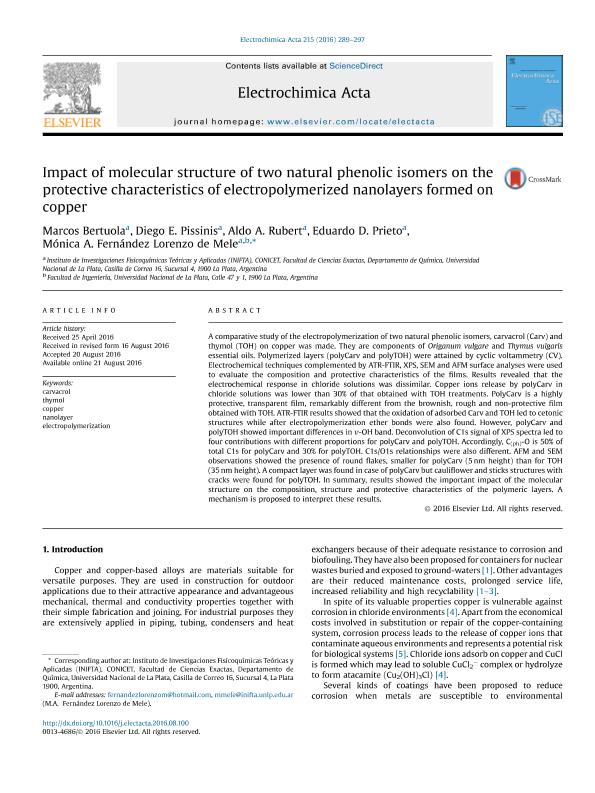Mostrar el registro sencillo del ítem
dc.contributor.author
Bertuola, Marcos

dc.contributor.author
Pissinis, Diego Ezequiel

dc.contributor.author
Rubert, Aldo Alberto

dc.contributor.author
Prieto, Eduardo Daniel

dc.contributor.author
Fernandez Lorenzo, Monica Alicia

dc.date.available
2018-07-05T14:09:13Z
dc.date.issued
2016-10
dc.identifier.citation
Bertuola, Marcos; Pissinis, Diego Ezequiel; Rubert, Aldo Alberto; Prieto, Eduardo Daniel; Fernandez Lorenzo, Monica Alicia; Impact of molecular structure of two natural phenolic isomers on the protective characteristics of electropolymerized nanolayers formed on copper; Pergamon-Elsevier Science Ltd; Electrochimica Acta; 215; 10-2016; 289-297
dc.identifier.issn
0013-4686
dc.identifier.uri
http://hdl.handle.net/11336/51302
dc.description.abstract
A comparative study of the electropolymerization of two natural phenolic isomers, carvacrol (Carv) and thymol (TOH) on copper was made. They are components of Origanum vulgare and Thymus vulgaris essential oils. Polymerized layers (polyCarv and polyTOH) were attained by cyclic voltammetry (CV). Electrochemical techniques complemented by ATR-FTIR, XPS, SEM and AFM surface analyses were used to evaluate the composition and protective characteristics of the films. Results revealed that the electrochemical response in chloride solutions was dissimilar. Copper ions release by polyCarv in chloride solutions was lower than 30% of that obtained with TOH treatments. PolyCarv is a highly protective, transparent film, remarkably different from the brownish, rough and non-protective film obtained with TOH. ATR-FTIR results showed that the oxidation of adsorbed Carv and TOH led to cetonic structures while after electropolymerization ether bonds were also found. However, polyCarv and polyTOH showed important differences in ν-OH band. Deconvolution of C1s signal of XPS spectra led to four contributions with different proportions for polyCarv and polyTOH. Accordingly, C(ph)-O is 50% of total C1s for polyCarv and 30% for polyTOH. C1s/O1s relationships were also different. AFM and SEM observations showed the presence of round flakes, smaller for polyCarv (5 nm height) than for TOH (35 nm height). A compact layer was found in case of polyCarv but cauliflower and sticks structures with cracks were found for polyTOH. In summary, results showed the important impact of the molecular structure on the composition, structure and protective characteristics of the polymeric layers. A mechanism is proposed to interpret these results.
dc.format
application/pdf
dc.language.iso
eng
dc.publisher
Pergamon-Elsevier Science Ltd

dc.rights
info:eu-repo/semantics/openAccess
dc.rights.uri
https://creativecommons.org/licenses/by-nc-nd/2.5/ar/
dc.subject
Carvacrol
dc.subject
Copper
dc.subject
Electropolymerization
dc.subject
Nanolayer
dc.subject
Thymol
dc.subject.classification
Otras Ciencias Químicas

dc.subject.classification
Ciencias Químicas

dc.subject.classification
CIENCIAS NATURALES Y EXACTAS

dc.title
Impact of molecular structure of two natural phenolic isomers on the protective characteristics of electropolymerized nanolayers formed on copper
dc.type
info:eu-repo/semantics/article
dc.type
info:ar-repo/semantics/artículo
dc.type
info:eu-repo/semantics/publishedVersion
dc.date.updated
2018-06-25T01:03:15Z
dc.journal.volume
215
dc.journal.pagination
289-297
dc.journal.pais
Países Bajos

dc.journal.ciudad
Amsterdam
dc.description.fil
Fil: Bertuola, Marcos. Consejo Nacional de Investigaciones Científicas y Técnicas. Centro Científico Tecnológico Conicet - La Plata. Instituto de Investigaciones Fisicoquímicas Teóricas y Aplicadas. Universidad Nacional de La Plata. Facultad de Ciencias Exactas. Instituto de Investigaciones Fisicoquímicas Teóricas y Aplicadas; Argentina
dc.description.fil
Fil: Pissinis, Diego Ezequiel. Consejo Nacional de Investigaciones Científicas y Técnicas. Centro Científico Tecnológico Conicet - La Plata. Instituto de Investigaciones Fisicoquímicas Teóricas y Aplicadas. Universidad Nacional de La Plata. Facultad de Ciencias Exactas. Instituto de Investigaciones Fisicoquímicas Teóricas y Aplicadas; Argentina
dc.description.fil
Fil: Rubert, Aldo Alberto. Consejo Nacional de Investigaciones Científicas y Técnicas. Centro Científico Tecnológico Conicet - La Plata. Instituto de Investigaciones Fisicoquímicas Teóricas y Aplicadas. Universidad Nacional de La Plata. Facultad de Ciencias Exactas. Instituto de Investigaciones Fisicoquímicas Teóricas y Aplicadas; Argentina
dc.description.fil
Fil: Prieto, Eduardo Daniel. Consejo Nacional de Investigaciones Científicas y Técnicas. Centro Científico Tecnológico Conicet - La Plata. Instituto de Investigaciones Fisicoquímicas Teóricas y Aplicadas. Universidad Nacional de La Plata. Facultad de Ciencias Exactas. Instituto de Investigaciones Fisicoquímicas Teóricas y Aplicadas; Argentina
dc.description.fil
Fil: Fernandez Lorenzo, Monica Alicia. Consejo Nacional de Investigaciones Científicas y Técnicas. Centro Científico Tecnológico Conicet - La Plata. Instituto de Investigaciones Fisicoquímicas Teóricas y Aplicadas. Universidad Nacional de La Plata. Facultad de Ciencias Exactas. Instituto de Investigaciones Fisicoquímicas Teóricas y Aplicadas; Argentina
dc.journal.title
Electrochimica Acta

dc.relation.alternativeid
info:eu-repo/semantics/altIdentifier/doi/https://dx.doi.org/10.1016/j.electacta.2016.08.100
dc.relation.alternativeid
info:eu-repo/semantics/altIdentifier/url/https://www.sciencedirect.com/science/article/pii/S0013468616318242
Archivos asociados
